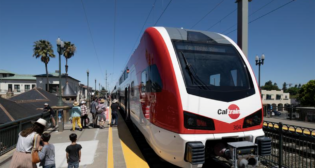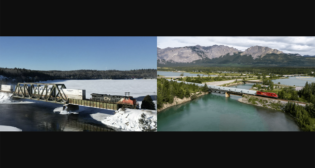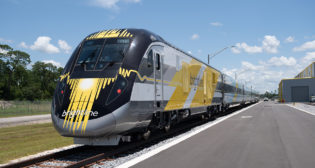
Chicagoans Celebrate CTA’s 75th
Written by David Peter Alan, Contributing Editor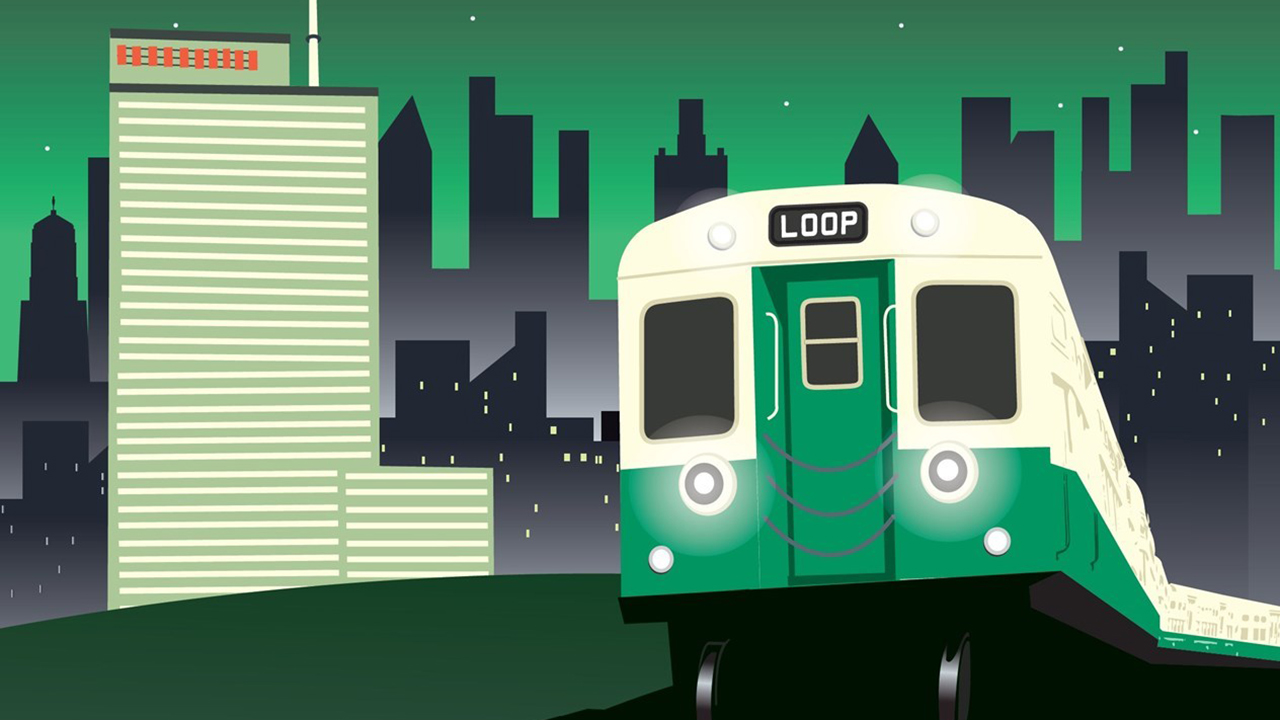
Saturday, Oct. 1 was sunny and cool, and windy, appropriate for the Windy City. It was a good fall day in Chicago, appropriate for the celebration that took place in the Loop, the city’s iconic piece of elevated rail infrastructure. The occasion was the 75th anniversary of the transfer of the city’s transit operations to the newly formed Chicago Transit Authority (CTA), which began consolidating all modes of the city’s local transit: elevated trains, the State Street Subway, streetcars, and buses (the Dearborn Street Subway came later) and continues to operate the city’s subway/elevated trains and buses today.
We previously reported on preparations for the diamond anniversary on Aug. 12, a report that also highlighted much of the history of the CTA and its equipment in anticipation of the event. We also featured an overview of the Chicago rail scene in the September issue of Railway Age, headlined Hub of the Midwest, as well as a feature on the historic North Shore interurban line, A Rich Rail Transit History.
The actual anniversary celebration was low-key, without ceremony and with little fanfare. Some agency employees, including from Media Relations, were on hand downtown to greet visitors and hand out tickets. If major CTA officials were also present, there was no publicity announcing their presence. There was a short press release headlined “Happy 75th, CTA!” and dated Sept. 28, which said: “‘For three-quarters of a century, the CTA has connected customers and communities to work, to school, to activities and to every vibrant Chicago neighborhood,’ said CTA President Dorval R. Carter, Jr. ‘This is an important milestone worth celebrating in appreciation for our customers, as well as our dedicated, hard-working employees, who over the past 75 years have kept CTA on track in providing the most equitable, accessible and affordable public transportation in the country!’” The big news was that the celebration would be brief, lasting only from 10:00 that morning until 2:00. By 9:30, a long line had formed, populated by folks who wanted their ticket to ride.
Despite the low-key nature of the event, the CTA provided plenty of information about its history on its website, www.transitchicago.com. The link to the information about the 75th anniversary is https://www.transitchicago.com/75th/. It includes a timeline of events since the CTA was founded, pictures of the historic cars, links to information about them, and photos from the agency’s archives.
Historic Equipment Rolled Out
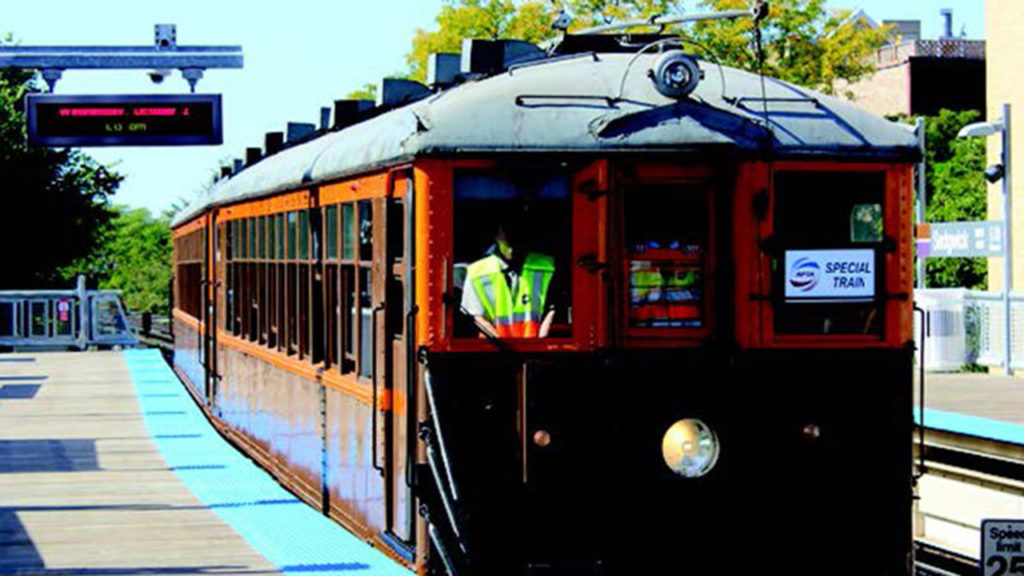
The highlight of the day was the return to the rails of equipment preserved for the agency’s Heritage Fleet. There were three special trains running. They were all confined to the Loop, the 1890s-vintage elevated structure that runs above Lake, Wells, and Van Buren Streets, and Wabash Avenue. The oldest train consisted of cars 4271 and 4272, built by the Cincinnati Car Company in 1923 and originally delivered to the Chicago Rapid Transit Company, and which remained in service until 1973. They sported a brown and orange livery from the 1930s, and featured an interior with walkover seats covered in brown leather. The original paint scheme was green and orange, and the last was the green and cream that the CTA adopted in the 1950s for all of its vehicles. It was that livery I remember from early visits to Chicago in 1969 and during the early 1970s. The earliest cars in the series were built in 1914, and some had trolley poles for running under overhead wire. Today, the Fox River Trolley Museum near Elgin has a car from that series, which sports the green and cream CTA livery and runs with a trolley pole. The two “4000-series” cars (the only pair that the CTA owns) were not the only historic cars that ran.
There were two other historic trains, as well. A two-car “6000-series” train, ran on the inner loop in the clockwise direction. Those cars, which resemble streetcars, were delivered in 1959 and retired in 1992. According to Bruce G. Moffat, a CTA retiree who is familiar with the agency’s history, the CTA was eliminating streetcar service in the late 1950s, and sent some its PCC (Presidents’ Conference Committee) cars to the St. Louis Car Company to be converted into cars that would run on the elevated and subway lines. The 6000-series cars, with their streetcar-style windows, doors and seats, were the result. The CTA owns two pairs of cars from that series of 720, and Nos. 6711 and 6712 ran behind the 4000s for the four-hour duration of the event.
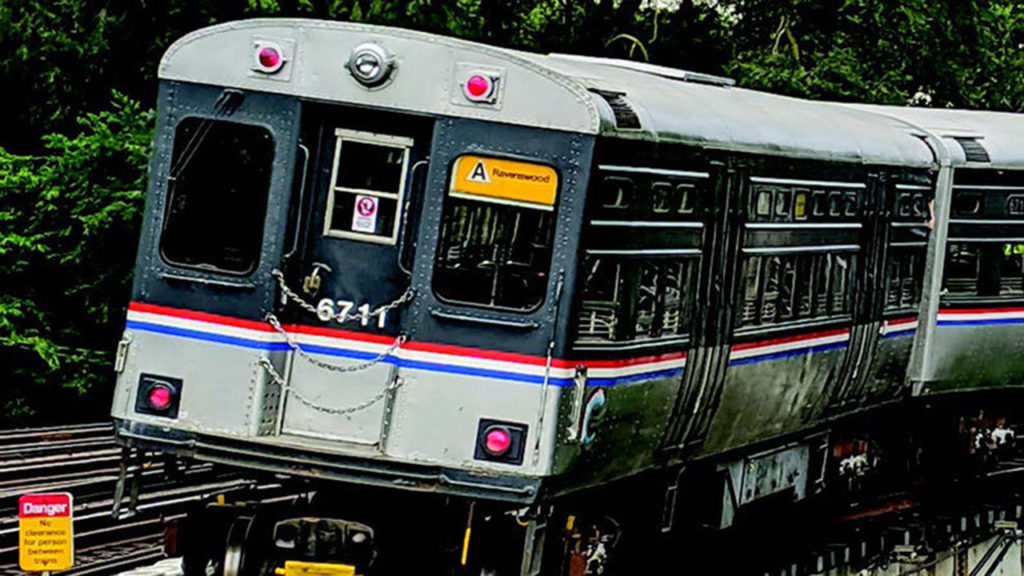
The other vintage train was built for the nation’s Bicentennial, and consisted of four cars numbered in the 2400-series and delivered between 1976 and 1978. They sported red-white-and-blue liveries, and ran around the outer loop in a counterclockwise direction. There were 200 cars made by Boeing-Vertol for the CTA, and they ran in revenue service until 1999.
Surprisingly, the cars presently in service that had been wrapped in other liveries of the past, and which the CTA had promoted so heavily during the summer, were nowhere to be seen around the Loop.
In addition, three buses from the 1960s were brought out for the event. One was on static display in Daley Plaza, and the other two made 15-minute trips around downtown Chicago. There was no fare charged to ride the buses, and the only charge to ride the historic trains was the regular CTA rail fare.
There is no doubt that one purpose of the day was to give Chicagoans a chance to ride special trains and buses, as their transit agency celebrated its special day. Railfans from New York and other far-off places joined the celebration, too. It was an enjoyable experience for everybody who rode, but perhaps the group who enjoyed it the most were the senior employees at the CTA and the agency’s retirees, who had a chance to “catch up on the old days” as they relieved those times on board. One senior CTA employee relished his role as conductor on the 6000-series train. He made announcements, called the stops, and stood between the cars to work the door controls, while he “rode again” as he did years ago with the old-style operation. Later he participated in the operation of the 4000-series cars. There was a lot of that sort of participation under the watchful eye of the employees in charge of the trains. This writer even got to hold the handle for the whistle cord and “blow a grade crossing” on Car 4271 while our train zoomed passed a station on the Loop, as we traversed the circuit non-stop.
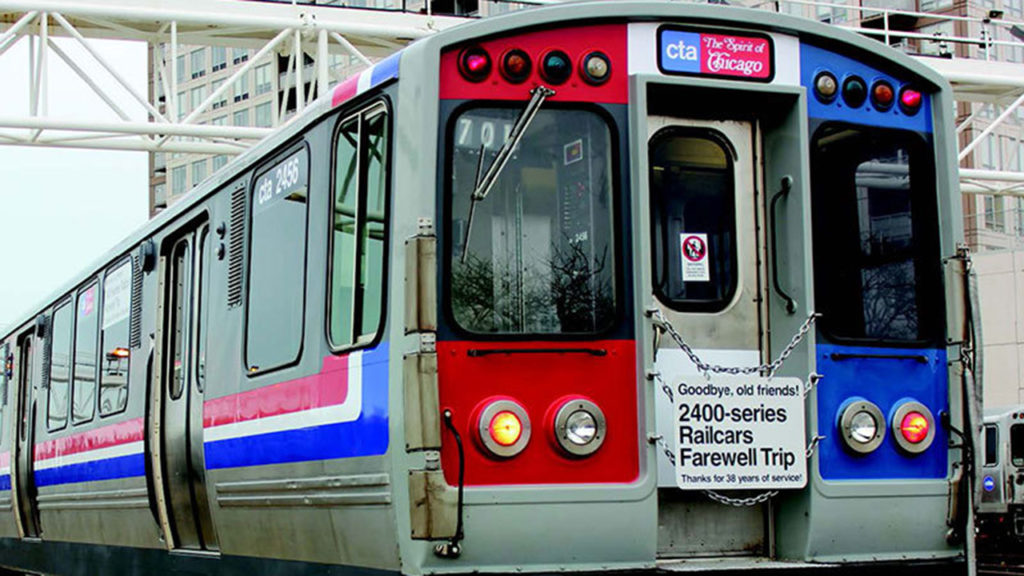
CTA Early Days a Rough Ride
One of the retirees on board was Bruce G. Moffat, who spent 37 years with the agency and sported the uniform of the CTA’s rail predecessor, the Chicago Rapid Transit Company. Moffat told this writer that two of the three components of the original CTA were in financial trouble in 1945, when the Illinois legislature created the CTA. Those were the Chicago Rapid Transit Company, which ran the trains, and the Chicago Surface Lines, which operated the streetcars and some bus routes. The Chicago Motor Coach Company was in better financial condition, and was not absorbed into the CTA until 1952.
Moffat told Railway Age that CTA ownership “allowed universal and seamless transferring” (a benefit for riders), but “public ownership was very new” at the time, and the CTA was established as a standalone organization with no taxing power. According to Moffat, the operating revenue had to come from the farebox and incidental sources, which brought service cuts and money-saving moves like having streetcars converted into “L” cars, rather than purchasing new ones. The CTA and other transit authorities in Chicagoland, including Metra (which operates regional rail around Chicago) and PACE (which operates suburban bus routes) did not get such authority until the Regional Transportation Authority (RTA) was established in 1974. So, with the CTA came continued service, but with cuts, including the end of streetcar service in 1958.
A Part of Chicagoan Lives
There was one topic of on-board conversation that dominated the event: reminiscences from CTA employees and retirees, and from “ordinary” Chicagoans about how the agency had influenced their lives. Senior employees and retirees swapped “war stories” about their experiences at the agency, while junior employees listened with rapt attention.
One of those retirees, with whom this writer had taken several rides, was Steven P. Hastalis, who had a 35-year career with the agency doing community outreach, customer service, and work related to the ADA (Americans with Disabilities Act). Both before and since he retired, Hastalis has advocated for better transit through the Rail Users’ Network (RUN) and on behalf of other blind persons through the National Federation for the Blind (NFB). He described one of his earliest experiences on the CTA: “When I was four, I was scared of the noise of the train but, when we got downtown, I felt I had arrived somewhere.” He added that he was inspired to work for the CTA by a friendly bus driver named Bob, who told him about the agency while he rode the bus. As a CTA employee, Hastalis said that he dedicated his career to making blind people and other persons with disabilities feel comfortable riding transit. On the ride, a number of his former colleagues recognized him and greeted him warmly.
The same happened to Norm Carlson, a retired accountant, with whom I rode my first trip around the Loop. Today, Carlson is Vice Chair of Metra’s Board of Directors, a Railway Age contributor, and Managing Editor of First & Fastest, a locally published magazine about railroad history in the region.
In many ways, it seemed like the event was, in essence, a four-hour reunion for CTA employees and retirees, and their friends. It had the feeling of “one big, happy family” of diverse backgrounds, but who shared the pride and history of the rail transit community. Fortunately, the public was invited, too.
Of course, the railfans rode, and they came out in force. One of them, Dan Kelly, identified himself as “a local guy who likes to ride.” He told Railway Age that he “fell in love with electric traction as a twelve-year-old, when the Evanston Line (today’s Purple Line) still had overhead.” Now Kelly operates “electric traction” at the Fox River Trolley Museum.
Another Rough Ride Ahead?
Saturday’s rides were components of a celebration. There was enough time to ride the 6000-series and 2400-series cars and the two 1960s-vintage buses, and still concentrate on beautifully restored cars 4271 and 4272. The talk was happy and full of nostalgia and warm greetings. It seemed that no other topics would be appropriate on a train that first saw service just short of a century ago and provided reliable local transportation for half of that century. But outside of the trip, there were bittersweet memories, and words of concern about the CTA and its future. Hastalis, for one, recalled when, as a boy, he rode streetcars on Clark Street on June 21, 1958, the last day they ever ran in the city.
Could the Windy City and its transit riders be in for another rough ride in the near future? Longtime advocate and journalist and Railway Age contributor F.K. Plous is concerned that it does. Plous told this writer “that the CTA was formed in 1947 for the same reason as most municipal transit agencies: Two generations of government-financed roads had made it impossible for privately owned transit to compete with government subsidies to private autos.”
Transit almost everywhere seems to be in some sort of trouble, as we have reported lately. Plous related some of the problems that he sees with Chicago’s transit: “There are numerous deficiencies in the way the CTA is structured, managed and operated, and I certainly would fault the way its future is being planned. The $2 billion-plus program to expand the Red Line down to 130th Street will have virtually zero effect on what should be the CTA’s primary mission: converting as much travel as possible from private auto to rail transit (and, secondarily, to bus transit). If the CTA even has such a goal I have never read about it and I certainly don’t see any evidence of it. And any plans for a stronger role for the CTA remain blocked by the current crime problem on the Red and Green lines. It is out of control, as is the problem of poor people using the CTA as their living quarters.”
Plous praised some construction projects on the North Side, especially the new Belmont Flyover on the Brown Line, which facilitates operations there, but he concluded, “I honestly wonder whether the line will be able to grow its ridership when so many people are deserting the system. This is not a good time for transit in Chicago, and CTA management does not have a plan.”
This writer has heard other people complain about the crime problem on the Red Line, and about crime on other transit systems, including in New York. It is true that the COVID virus has caused ridership to decline everywhere, and we have been keeping track of that development at Railway Age. Even as the pandemic subsides, more people will work from home, at least some days of the week, than they did before the virus struck more than 2½ years ago. Transit managers everywhere will need to take action to stay relevant in the wake of reduced ridership. There is also a “fiscal cliff” coming when the COVID relief funding runs out. Will cities, states, and even the federal government be willing, or even able, to step up to the plate and keep the nation’s transit going? Time will tell, but the time to plan for it is now.
A “Sentimental Journey”?
As I write this, I am reminded of Les Brown’s 1944 hit Sentimental Journey, which became a post-war classic, as recorded by his “Band of Renown” with singer Doris Day. In the fourth line of the song, lyricist Bud Green expressed the purpose of the trip is “to renew old memories.” To me, although I did not realize it when I planned the trip, its purpose for me turned out to be more than merely covering an event that was enjoyable and nostalgic in its own right, it was also the one expressed in the song.
I took my first long-distance train trip in 1969, during my undergraduate days, and I went to Chicago. I rode Penn Central’s equivalent of today’s Amtrak Lakeshore Limited, which had lost its official name, but still had a dining car that served freshly made food and an economy sleeping car, a pleasant trip and still suitable for a student’s budget. After I arrived in town on that first trip, I rode the 4000-series cars and had always hoped to ride them again, even though they were taken out of service in 1973. I rode the Evanston Express, the Skokie Swift, the Ravenswood Line and the Oak Park Elevated (today’s Purple, Yellow, Brown and Green Lines). That was more than 53 years and almost a million miles ago. This time, I rode the same four lines on Friday and the historic cars on Saturday, and rode both directions on Amtrak’s Lakeshore.
There may be more hard times ahead for the CTA and for transit generally, but the CTA has kept Chicagoans moving for 75 years, for better or worse, and the hard-working folks who have dedicated their careers to keeping Chicagoans moving deserved to take a break for a few hours, ride on a historic train, reminisce about transit, and give each other a “good for you” for all those long years. It was a great experience to share. Our train eventually escaped from the Loop, and we were allowed to ride non-stop from Washington and Wells Streets to Howard Avenue. The trip took 47 minutes.
